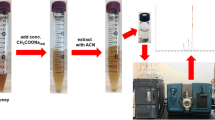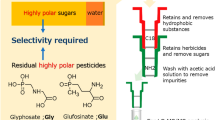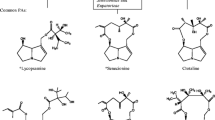Abstract
A reversed phase (RP) liquid chromatography tandem mass spectrometric (LC-MS/MS) method was developed and validated to confirm and quantitate trace levels of fumagillin and dicyclohexylamine (DCH) residues in honey destined for human consumption. Chromatographic resolution of DCH and fumagillin, including the latter’s biologically active UV degradation products, was achieved using a C18 analytical column. A deuterium labelled d10-DCH internal standard was synthesized in a one-pot reaction from readily available starting materials and was used to compensate for observed matrix affects when quantitating DCH in honey from different floral origins. Sample extraction was achieved by using reversed phase polymeric solid phase extraction (SPE) with recoveries (±RSD%) at 10, 100 and 500 ng g−1 for 18 replicates at each respective concentration calculated as 105.7 ± 10.8, 100.8 ± 9.3 and 104.3 ± 8.7 for fumagillin and as 104.0 ± 5.9, 98.3 ± 6.9 and 104.0 ± 9.7 for DCH. Domestically produced honey samples (n = 16) were analyzed for fumagillin and DCH, and screened for UV-decomposed fumagillin, without having any prior knowledge of whether fumagillin was used in the bee colonies from which the honeys were produced. No UV-decomposed fumagillin could be detected in any of the samples. Fumagillin was detected in 11 of the 16 samples at levels below 10 ng g−1, and only in 2 samples at levels above 10 ng g−1 (11.9 and 11.6 ng g−1, respectively). DCH was detected in all of the tested samples with concentrations above 10 ng g−1 being observed for 15 out of the 16 samples, with concentrations ranging from 20.0 to 234.6 ng g−1.





Similar content being viewed by others
References
Assil HI, Sporns P (1991) ELISA and HPLC methods for analysis of fumagillin and its decomposition products in honey. J Agric Food Chem 39:2206–2213
Bailey L (1953) Effect of fumagillin upon Nosema apis (Zander). Nature 171:212–213
Botías C, Martín-Hernández R, Garrido-Bailón E, González-Porto A, Martínez-Salvador A, De La Rúa P, Meana A, Higes M (2012) The growing prevalence of Nosema ceranae in honey bees in Spain, an emerging problem for the last decade. Res Vet Sci 93:150–155
Brackett JM, Arguello MD, Schaar JC (1988) Determination of fumagillin by high performance liquid chromatography. J Agric Food Chem 36:762–764
Brorström-Lundén E, Hansson K, Remberger M, Kaj L, Magnér J, Andersson H, Haglund P, Andersson R, Liljelind P, Grabic R (2011) Screening of benzothiazoles, benzenediamines, dicyclohexylamine and benzotriazoles. IVL Report B2023:1–53
CAPA: Proceedings of the Canadian Association of Professional Apiculturists (2013) http://capabees.org/content/uploads/2012/11/2013-CAPA-AGM-Proceedings.pdf
Chambers E, Wagrowski-Diehl DM, Lu Z, Mazzeo JR (2007) Systematic and comprehensive strategy for reducing matrix affects in LC/MS/MS analyses. J Chromatogr B 852:22–34
Cox-Foster DL, Conlan S, Holmes EC, Palacios G, Evans JD, Moran NA, Quan P-L, Briese T, Hornig M, Geiser DM, Martinson V, vanEngelsdorp D, Kalkstein AL, Drysdale A, Hui J, Zhai J, Cui L, Hutchinson SK, Simons JF, Egholm M, Pettis JS, Lipkin WI (2007) A metagenomic survey of microbes in honey bee colony collapse disorder. Science 318:283–287
Dmitrovic J, Durden DA (2013) Analysis of fumagillin in honey by LC-MS/MS. J AOAC Int 96:687–695
El-Matbouli M, Hoffmann RW (1991) Prevention of experimentally induced whirling disease in rainbow trout Oncorhynus mykiss by fumagillin. Dis Aquat Org 10:109–113
Fries I (2010) Nosema ceranae in European honey bees (Apis mellifera). J Invertebr Pathol 103:S73–S79
Gochnauer TA, Furgala B (1962) The nosema inhibitory activity of alcohol I, a component of fumagillin. J Insect Pathol 4:489–491
Greim H, Bury D, Klimisch H-J, Oeben-Negele M, Ziegler-Skylakakis K (1998) Toxicity of aliphatic amines: structure-activity relationship. Chemosphere 36:271–295
Guyonnet J, Richard M, Hellings P (1995) Determination of fumagillin in muscle tissue of rainbow trout using automated ion-pairing liquid chromatography. J Chromatogr B 666:354–359
Hanson FR, Eble TE (1949) An antiphage agent isolated from Aspergillus sp. J Bacteriol 58:527–529
Heil J, Reifferscheid G, Waldman P, Leyhausen G, Geurtsen W (1996) Genotoxicity of dental materials. Mutat Res 368:181–194
Higes M, Martín-Hernández R, Botías C, Garrido-Bailón R, Gonzales-Porto AV, Barrios L, Nozal MJ, Bernal JL, Jimenez JJ, Palencia PG, Meana A (2008) How natural infection by Nosema ceranae causes honeybee colony collapse. Environ Microbiol 10:2659–2669
Higes M, Martín-Hernández R, Garrido-Bailón E, Gonzalez-Porto AV, Garcia-Palencia P, Meana A, del Nozal MJ, Mayo R, Bernal JL (2009) Honeybee colony collapse due to Nosema ceranae in professional apiaries. Environ Microbiol Rep 1:110–113
Higes M, Martín-Hernendez R, Meana A (2010) Nosema ceranae in Europe: an emergent type C nosemosis. Apidologie 41:375–392
Higes M, Nozal MJ, Alvaro A, Barrios L, Meana A, Martín-Hernández R, Bernal JL, Bernal J (2011) The stability and effectiveness of fumagillin in controlling Nosema ceranae (Microsporidia) infection in honey bees (Apis mellifera) under laboratory and field conditions. Apidologie 42:364–377
Kanda M, Sasamoto T, Takeba K, Hayashi H, Kusano T, Matsushima Y, Nakajima T, Kanai S, Takano I (2011) Rapid determination of fumagillin residues in honey by liquid chromatography-tandem mass spectrometry using the QuEChERS method. J AOAC Int 94:878–885
Katznelson H, Jamieson CA (1952) Control of Nosema disease of honeybees with fumagillin. Science 115:70–71
Kent ML, Dawe SC (1994) Efficacy of fumagillin DCH against experimentally induced Loma salmonae (Microsporea) infections in Chinook salmon Oncorhynus tshawytscha. Dis Aquat Org 20:231–233
Kochansky J, Nasr M (2004) Laboratory studies on the photostability of fumagillin, the active ingredient of Fumadil B. Apidologie 35:301–310
Kulić M, Aleksić N, Stanimirović Z, Ristić S, Medenica S (2009) Examination of genotoxic effects of fumagillin in vivo. Genetika 41:329–338
Lopez MI, Pettis JS, Barton Smith I, Chu P-S (2008) Multiclass determination and confirmation of antibiotic residues in honey using LC-MS/MS. J Agric Food Chem 56:1553–1559
Martínez J, Leal G, Conget P (2012) Nosema ceranae an emergent pathogen of Apis mellifera in Chile. Parasitol Res 111:601–607
Molnar K (1994) Recent achievements in the chemotherapy of myxosporean infections of fish. Acta Vet Hung 41:51–58
Mortelmans K, Haworth S, Lawlor T, Speck W, Tainer B, Zeiger E (1986) Salmonella mutagenicity tests: II. Results from the testing of 270 chemicals. Environ Mol Mutagen 8(Supl 7):1–119
Nozal MJ, Bernal JL, Martín MT, Bernal J, Alvaro A, Martín R, Higes M (2008) Trace analysis of fumagillin in honey by liquid chromatography-diode array-electrospray ionisation mass spectrometry. J Chromatogr A 1190:224–231
Pegg AE, Bitonti AJ, McCann PP, Coward JK (1983) Inhibition of bacterial aminopropyltransferases by S-adenosyl-1,8-diamino-3-thiooctane and by dicyclohexylamine. FEBS Lett 155:192–196
Pelter A, Rosser RM, Mills S (1984) Reductive aminations of ketones and aldehydes using borane-pyridine. J Chem Soc Perkin Trans 1:717–720
Pliss GB (1958) On the carcinogenic activity of dicyclohexylamine and dicyclohexylamine nitrite. Vopr Onk 4:659–667 (Abstract accessed on http://toxnet.nlm.nih.gov on 29 October 2013)
Purchase IFH, Longstaff E, Ashby J, Styles JA, Anderson D, Lefevre PA, Westwood FR (1978) An evaluation of 6 short-term tests for detecting organic chemical carcinogens. Br J Cancer 37:873–903
Stanimirović Z, Stevanović J, Kulić M, Stojic V (2006) Frequency of chromosomal aberrations in the evaluation of genotoxic potential of dicyclohexylamine (fumagillin) in vivo. Acta Vet (Beograd) 56:353–366
Stanimirović Z, Stevanović J, Bajic V, Radovic I (2007a) Evaluation of genotoxic effects of fumagillin by cytogenic tests in vivo. Mutat Res 628:1–10
Stanimirović Z, Ivana PI, Kulišić Z, Milanka D (2007b) Evaluation of genotoxic effects of fumagillin by sister chromatide exchange and chromosomal aberration tests in human cell cultures. Acta Vet (Beograd) 57:257–273
Stanimirović Z, Aleksić N, Kulić M, Maletić M (2010) Fumagillin-induced chromosome aberrations in mouse bone-marrow cells. Arch Biol Sci Belgrade 62:47–55
Stevanović J, Stanimirović Z, Ivana PI, Lazarević M (2006) Monitoring of mitotic index and frequency of micronuclei in evaluation of genotoxic potential of fumagillin (dicyclohexylamine) in vivo. Acta Vet (Beograd) 56:437–448
Stevanović J, Stanimirović Z, Radakovic M, Stojic V (2008) In vitro evaluation of the clastogenicity of fumagillin. Environ Mol Mutagen 49:594–601
Stoltz DR, Khera KS, Bendal R, Gunner SW (1970) Cytogenetic studies with cyclamate and related compounds. Science 167:1501–1502
van den Heever JP, Thompson TS, Curtis JM, Ibrahim A, Pernal SF (2014) Fumagillin: an overview of recent scientific advances and their significance for apiculture. J Agric Food Chem 62:2728–2737
Van Eeckhaut A, Lanckmans K, Sarre S, Smolders I, Michotte Y (2009) Validation of bioanalytical LC-MS/MS assays: evaluation of matrix effects. J Chromatogr B 877:2198–2207
vanEngelsdorp D, Evans JD, Saegerman C, Mullin C, Haubruge E, Nguyen BK, Frazier M, Frazier J, Cox-Foster D, Chen Y, Underwood R, Tarpy DR, Pettis JS (2009) Colony collapse disorder: a descriptive study. PLoS ONE 4:e6481. doi:10.1371/journal.pone.0006481
Williams GR, Sampson MA, Shutler D, Rogers REL (2008) Does fumagillin control the recently detected invasive parasite Nosema ceranae in western honey bees (Apis mellifera)? J Invertebr Pathol 99:342–344
Williams GR, Shutler D, Little CM, Burgher-MacLellan KL, Rogers REL (2011) The microsporidian Nosema ceranae, the antibiotic Fumagilin-B®, and western honey bee (Apis mellifera) colony strength. Apidologie 42:15–22
Woldegiorgis A, Wiklund P, Remberger M, Kaj L, Viktor T, Lilja K, Brorstrom-Lunden E, Dye IC (2007) Results from the Swedish National Screening Programme 2007, Sub Report 1: Amines IVL Report B1817, 1–36
World Health Organisation (2010) Codex Alimentarius Commission E: Joint FAO/WHO Food Standards Programme Codex Committee on Residues of Veterinary Drugs in Foods, Nineteenth Session, ftp://ftp.fao.org/codex/meetings/CCRVDF/ccrvdf19/rv19_10e.pdf
Compliance with Ethics Requirements
Conflict of Interest
Johan P. van den Heever declares that he has no conflict of interest.
Thomas S. Thompson declares that he has no conflict of interest.
Jonathan M. Curtis declares that he has no conflict of interest.
Stephen F. Pernal declares that he has no conflict of interest.
This article does not contain any studies with human or animal subjects.
Author information
Authors and Affiliations
Corresponding author
Rights and permissions
About this article
Cite this article
van den Heever, J.P., Thompson, T.S., Curtis, J.M. et al. Determination of Dicyclohexylamine and Fumagillin in Honey by LC-MS/MS. Food Anal. Methods 8, 767–777 (2015). https://doi.org/10.1007/s12161-014-9956-x
Received:
Accepted:
Published:
Issue Date:
DOI: https://doi.org/10.1007/s12161-014-9956-x




